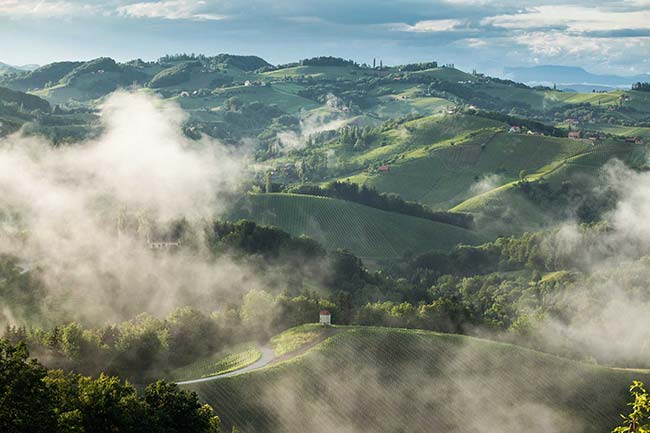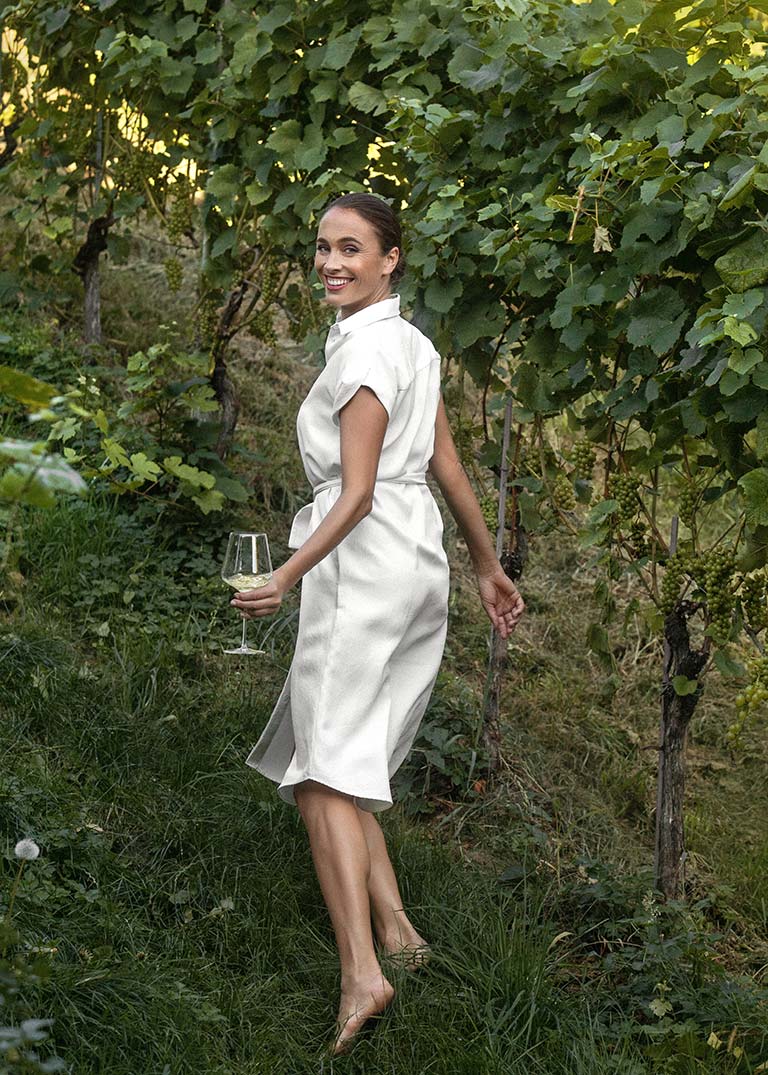Terroir
Southern Styria

There are areas that are simply magical, fairytale-like. Or even a little enchanted, almost as if from another world. This is also true of southern Styria, which literally grounds you with its gently rolling hills, forested peaks and fertile vineyards. There is something almost meditative about the peace and tranquillity that this vineyard-green landscape radiates. One feels a deep sense of happiness and pure, inner peace here.
Kreuzberg
Besonders die Gegend um den 633 Meter hohen Kreuzberg mit ihrem mediterran-illyrischem Klima, langen, warmen Sommertagen und kühlen Nächten, verstärkt den Eindruck, an einem historisch gewachsenen Kraftort zu sein. Schon die Illyrer, Kelten und später die Römer, kultivierten hier ihre Weinreben.
Auch heute noch ist die Südsteiermark, die „steirische Toskana“, wie sie gerne genannt wird, ein Stück intakter Natur und vor allem: Genusslandschaft. Mit zahlreichen Hauben-Lokalen und urigen Buschenschänken. Ein verstecktes Paradies aus einer scheinbar längst vergangenen Zeit – im Hier und Jetzt. Ein Ort für die Sinne. Ein Zuhause für Gourmets und Weinliebhaber.
Genau hier, in dieser großen Weißweinregion, die auf „Augenhöhe“ und auf dem gleichen 46.-47. Breitengrad liegt wie die Anbaugebiete Montrachet, Chablis, Sancerre oder Südtirol, kreiert „hidden Champion“ Thomas Rothschädl SIGNUM BLANC. Jeder Schluck erzählt die Geschichte seines Ursprungs und seiner Herkunft. Reife, elegante Weine mit feiner Frucht, ausgewogener Säure und einer mineralischen Note im Abgang. Das Ergebnis eines genialen Terroirs und eines kongenialen Weinmachers.

Summer on the Kreuzberg
Tourmaline

Latest find 15.05.2021
Replanting in the vineyard
Kreuzberg / Leutschach
Turmalin
SIGNUM BLANC wächst auf turmalinhaltigem Felsboden, einem einzigartigen Terroir am Kreuzberg in der Südsteiermark.
Dort ist in dem lockeren metamorphen Gestein, in dem die Reben tief im Fels wurzeln und bis in feinste Ritzen dringen, schwarzer Turmalin enthalten, wie eine Bodenanalyse 2019 bestätigte. Geologisch gesprochen „beißt“ der Turmalin bei den SIGNUM BLANC Reben am Kreuzberg aus: er tritt zu Tage und durchzieht gleichzeitig die tiefen Gesteinsschichten.
Dieser Edelstein, der im Boden des Kreuzbergs seit Millionen Jahren unter den Rebstöcken ruht, ist ein wahrer „Schatz“. Als Schmuckstein ist schwarzer Turmalin mysteriös und magisch schön, aber er ist auch eines: energetisch wertvoll.
The power, energy and minerality of the black gemstone is absorbed by the fine deep roots of the vines, which wander persistently through the rocky, humus-poor soil in search of nutrients and minerals. It is precisely this power, energy and minerality that passes through the roots into the hand-picked grapes and is later intensified by the wine’s long maturation in the cellar.
The aromas are more condensed, more concentrated, resulting in a very characterful wine. – “Noble stone, noble wine!”
SIGNUM BLANC hat „Vinergie“.
Und die spürt man, Schluck für Schluck.
Geographical location and climate
The Illyrian climate of southern Styria is an Alpine-Adriatic climate and prevails in Austria’s southeast and in parts of Slovenia. Protected by the Alpine barrier, the summers there are still as you remember them as a child: warm, sunny and endless. These summers transition very slowly into a golden autumn. Warm days, cool nights in early summer, a summer sun average of over 20 degrees ensure that the wine can develop optimal fruit.
Illyrian climate brings more humidity than a Mediterranean climate. As it grows, the vine loves the showers and thunderstorms that the Adriatic occasionally sends up. In some phases of the summer, the wine in southern Styria also enjoys a Pannonian climate, dry and with little precipitation. The grapes dry out and stretch out towards the sun.
Illyrian climate is a gifted climate, rich in variety and unpredictable. In this respect, Styrian winegrowers have a tradition of maintaining a good relationship with the weather god. They are rewarded with magnificent vintages.
Contact
[wpforms id=”199″ title=”false”]
Edler Stein, edler Wein:
SIGNUM BLANC setzt ein Zeichen in der Welt der Weine.
Ein Zeichen für das Besondere, das Kostbare, das Exklusive.
Denn SIGNUM BLANC ist ein Edelstein-Wein, so reich- und gehaltvoll wie der turmalinhaltige Boden, auf dem seine Reben in den steilen Hängen in der Südsteiermark, Österreichs südlichstem Weinbaugebiet, wachsen.




